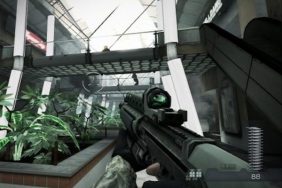When Bungie announced that it had freed itself of the shackles of its Microsoft partnership, it was a big day for gamers. Although it would lose rights to the legendary Halo franchise, the same one that it earned its reputation from, it would be given the freedom needed to craft whatever it wanted, and for its widest audience ever. The sky was the limit, and the sky is where it aimed.
Since then, Bungie has been working on Destiny, a multiplatform title with tremendous ambition. Bungie says that it’s the best game it’s ever developed, but is it really?
Destiny is set in the distant future where humanity has expanded its boundaries by colonizing the solar system. Although this advance in technology has allowed your species to explore the far reaches of our star system, it has also presented you with a serious threat: hostile aliens. Following a series a pre-game events that leave humanity in tatters, it’s up to you as the protagonist to rise up and combat foreign lifeforms to take back what is rightfully yours.
If you think that sounds a bit familiar, you aren’t alone. Truth is, Destiny‘s story is derivative of many works seen in gaming and film. However, it’s far less interesting than its counterparts. The narrative is delivered with uneventful, unskippable cutscenes and in-game dialog that rarely are deserving of attention. Consequently, this isn’t the gripping tale of Bungie’s past works.

Mars is just one of five major locations you can visit. Each has a distinctive theme.
That said, being able to visit a variety of celestial bodies is one of Destiny‘s greatest strengths. There are five locations in total, which include places you’ve been before (i.e. Moon, Mars, and Earth), but also Venus. Each of these locations have a distinct vibe. Some of that is due to the soundtrack, which is one of the best you’ll ever hear (composed by Paul McCartney and two other prolific composers), while most of it is due to the vastly different environmental styles. While the Moon has a monotone chalky surface, Venus is bubbling with heat and bright colors. As strange as it might sound, the skyboxes are arguably the best part of the presentation. Combating enemies with a beautiful view of Earth and deep space in the background is a sight to behold. No other game does it better.
Playing Destiny, you can tell that it’s a game made by Bungie. Gunplay is extremely precise, with attacks and hits telegraphed well both visually and acoustically. Unfortunately, these cohesive mechanics aren’t supported by much. For one, the weapon variety is very limited. Instead of presenting creative weapons that have a variety of primary and secondary firing modes, just about every weapon in the game is assigned a single, simple mechanic, such as single-fire or burst-fire. There is some deviation, but it isn’t enough to keep the game interesting during long play sessions.
Made worse, you can only carry three weapons at a time, and two of those slots are special weapons with limited ammunition. So, for the most part, you’ll tackle hundreds of enemies per hour with your primary weapon, with little variance.
Destiny’s game design is conflicted. On one hand, it aspires to be a highly social experience with MMO qualities. Unfortunately, it tries to balance being a story-driven console shooter and online-focused game so much that it doesn’t succeed at either, and has nothing to make up for it.

You will combat a ton of enemies with only a few weapon options.
In regards to its MMO qualities, Destiny has world design unlike any other. Essentially, it has five major locations (3 planets, 1 moon, 1 main hub) that have open-world qualities. When you land at a location, you share the space with several other random players, although you can defer to team up with a couple others to attack objectives with a communicative group. Each location has its own missions, several of which are story-progression based and linear, while a few are called Patrols, which allow you to explore the space and look for glowing beacons to pick-up simple quests, which are usually as simple as kill X amount of enemies.
The main hub, called The Tower, is a small, enemy-less village where, like the outdoor locations, have other players running around. It serves as a place of respite, gear acquisition, NPC interaction, and bounty collection. However, unlike virtually every MMO on the market, there is only one town, and that likely means you’ll quickly become fatigued with running around the same space, especially given that it has an unreasonably long loading time.
Also See: A Guide to Choosing a Destiny Class
What destroys any sense of social interaction is how poorly communication is handled in Destiny. When in open hubs, you can’t type or voice chat with other players, so those opportunities to have small exchanges with other players that make MMOs so unpredictable don’t really happen here. So, you’ll need to make friends. If you don’t already have enough friends to play with, you can send PSN/XBL invites to random people you play with, but that’s a big step just to be able to speak with one another.
Additionally, these environments are much more limited in scope than you have been led to believe. While you are able to move between planets, the total real estate isn’t sizable. Also, you will revisit locations frequently, especially the game’s dungeons. Sometimes three or four quests are completed in the same linear space. Destiny might be a game that stretches across a star system, but its map space feels less substantial than just about any modern AAA RPG (i.e. The Witcher 2, Skyrim, Mass Effect 3, etc.).

The journey isn’t as deep as it appears.
The biggest downfall of Destiny is its repetitive quest structure. 90% or more of the quests boil down to killing seemingly endless waves of enemies, occasionally pressing a button to have your Ghost companion (voiced by Peter Dinklage) interact with the environment. There is very little else going on. This, combined with the limited weapon design, makes for one of the most boring AAA experiences you’ll play this year.
There are Strikes and Raids, which expend their effort in being difficult, warranting co-operative play, but they suffer from the same shortcomings of the basic quests. You kill tons of enemies, and occasionally battle a boss. Don’t expect much from the bosses, either. They are the first-person shooter version of a tank-and-spank in MMORPGs.
To be fair, the enemy design in Destiny is good. There is some variety that summons strategy, including enemies that can deploy shields, and those that are highly elusive. Made better, the artificial intelligence is impressive. Enemies know how to dodge your attacks, and present a fair challenge.
Most of Destiny‘s entertainment value comes in the form of character progression. At the start of your journey, you’re able to design a character with a moderate amount of options. Those options consist of choosing from three races (Human, Exo, Awoken), three classes (Hunter, Warlock, Titan), and the aesthetics of your character. There is skill progression, but it’s as simple as you’ll ever see; there is only one significant choice to make, and it comes in the form of choosing a specialization at 15. Other than that, most of the game is on auto-pilot.
Playing through Destiny, you’ll encounter weapon and armor drops, as well as currency. Sadly, as mentioned before, the weapon variety is poor, and the armor models are limited despite there only being three classes.
At the end of the day, it doesn’t take long to reach the level cap of 20. After that, there are only three classes total, each of which don’t have much to tinker with. As such, a second play through is unlikely to be of interest to you. So, you’ll rely on tackling endgame PvE content, which is structured very similar to most MMOs, but with far less options. Or, you can visit The Crucible, which is the game’s solution for PvP/competitive players. As far as The Crucible goes, it’s highly unlikely to capture your long-term attention. Overpowered weapons and abilities completely jeopardize balance, and map design is sub-average. Chances are you’ll permanently turn back to a PvE focus after your first few sessions.
Also See: 9 Fun Things to Do in Destiny
Ultimately, Destiny is a beautiful but unsatisfying game. It tries too hard to blur the boundaries between a story-driven shooter and MMOFPS, and ends up proficient at neither. It gets a few things right, especially gunplay and presentation, but falters in the areas that most affect long-term playability. It’s not the rich online world it aspires to be. Instead, it’s an underdeveloped framework of a game that could have been the most important new IP of the generation.

Jonathan Leack is the Gaming Editor for CraveOnline. You can follow him on Twitter @jleack.
Copy provided by publisher. Destiny is available on Xbox One, Xbox 360, PS4, and PS3.
Destiny Gallery
-
Destiny Gallery #1

-
Destiny Gallery #2

-
Destiny Gallery #3

-
Destiny Gallery #4

-
Destiny Gallery #5

-
Destiny Gallery #6

-
Destiny Gallery #7

-
Destiny Gallery #8

-
Destiny Gallery #9

-
Destiny Gallery #10

-
Destiny Gallery #11

-
Destiny Gallery #12

-
Destiny Gallery #13

-
Destiny Gallery #14

-
Destiny Gallery #15

-
Destiny Gallery #16

-
Destiny Gallery #17

-
Destiny Gallery #18

-
Destiny Gallery #19

-
Destiny Gallery #20

-
Destiny Gallery #21

-
Destiny Gallery #22

-
Destiny Gallery #23

-
Destiny Gallery #24

-
Destiny Gallery #25

-
Destiny Gallery #26

-
Destiny Gallery #27

-
Destiny Gallery #28

-
Destiny Gallery #29

-
Destiny Gallery #30

-
Destiny Gallery #31

-
Destiny Gallery #32









